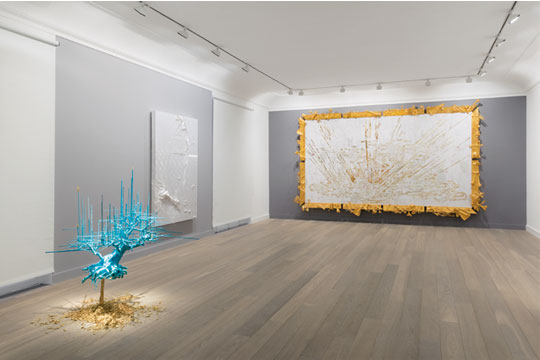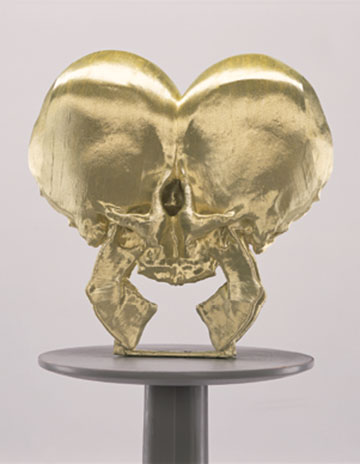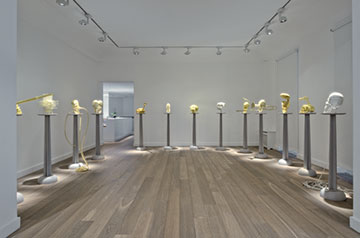LIN TIANMIAO: EST-CE PERMIS ? (EST-CE POSSIBLE?)
| March 22, 2014 | Post In 2014年2月号

(Est-ce possible?),” 2013
Galerie Lelong, Paris,
France
Within Chinese contemporary art discourse, there is often no distinction made between “female artist” and “feminist artist.” Thus, for Lin Tianmiao, escaping the mutual entanglement of these two concepts, both of which play a part in her practice, is simply impossible. The former generally places an essentialist emphasis on female identity, in her case focusing on interpretations of the female symbolism in and characteristics of her work, such as her use of needle and thread, lace, cloth, silk, as well as of weaving, sewing, and embroidery—all things which are regarded as self-consciously feminine manifestations of the “feminine arts.” She is also regarded as a feminine (female) artist based on her use of other symbols such as hair, skin, the body, birth, and sex—all considered to be intrinsic expressions of feminine perception. The term “feminist,” meanwhile, is thought to constitute a critical attitude (social, cultural, or political) towards essentialist notions of femininity. Accordingly, Lin, through the ambiguous treatment of the characteristics of her own female identity, the accumulation and use of various forms of femininity, and a consistent dissection of and scepticism towards female identity—all factors which problematize female identity, rather than accept it as a natural construct—illustrate that she is an artist who openly and self-consciously addresses feminist issues.

Colored silk threads, polyurea and metal constructions,
wood pedestal
Dimensions variable
Lin Tianmiao does not see any contradictions in simultaneously being a feminine and a feminist artist; with a feminist awareness, she treats feminine symbolism and female temperament in a conceptual, reflective manner. However, many of the tendencies clearly on display in her work, such as its materialist infatuations, its indulgence in complex handiwork, and its obsession with visual purity, should not be only discussed from the angle of gender. Indeed, limiting the understanding and critique of Lin’s work to questions of femininity is tantamount to cognitive laziness and inertia. This goes without even mentioning the fact that Lin has in recent years fully transcended issues of gender and gender consciousness.
On a certain level, her new solo exhibition at Galerie Lelong in Paris, “Est-ce permis? (Est-ce possible?),” can be seen as an appropriate conclusion to the transformation her work gradually underwent beginning in 2010. In the 2008 series “Mother’s!!!” headless, swollen female forms, hair, balls of thread, white ovular objects, rags, and the form of the cavity hinted at the exhibition’s sensual layout, meanwhile manifesting a gendered, bodily anxiety, their anchor again being individual self-perception. However, with the later series “The Same,” this gendered body and individualized self disappeared from Lin’s work, replaced by genderless, even bodiless, skeletal forms, along with a new field of perspective which completely transcends individual experience.
One work featured in this exhibition, titled The Same for N Times, was perhaps the first to fully represent this transformation. At first glance, the picture plane could either be taken straight from the origin of the universe, or from some kind of apocalyptic disaster. Between beams of energy, embroidered with golden thread, are specimens of insects and human remains, while the golden frame surrounding this is embedded with various kinds of human bones in miniature, the complete image appears like a kind of altar of archaeological artefacts. In this piece, the individualized angle which formerly characterized Lin’s work has been replaced by a vast, transcendent, symbolic field: in this field, human bones are both base and sacred, free from the shackles of meaning, and a symbol of the ultimate. According to Lin’s own explanation, the creation of this symbolic field, free of both self and gender, was influenced by the death of her mother: having faced death, Lin now feels even more strongly the equality between all people, animals, and things living or nonliving; this sentiment is also hinted at in the title of the series to which this piece belongs: “The Same.”

Colored silk threads, polyurea and metal constructions, wood pedestal
Dimensions variable
This approach, which jettisons attempts at meaning for the sake of a return to pure existence, is also embodied in Lin Tianmiao’s new attitude towards materiality: if her previous use of thread referred to subjective experiences such as labor and time, then in her new work, the dazzling tangles of silk thread, which seem to hold a multitude of color and splendor in their grasp, manifest as the objects of visuality itself. Indeed, these new works appear to exist primarily to be seen, as objects possessing no definite content. They could even be likened to the flaunting falsetto of Western opera, which seems to belong to a realm of abstract and pure existence. As the bones, utensils, and even frames featured here are covered by exquisitely fine, textured layers of silk thread, the audience’s attention is diverted away from any of the objects’ attributes, and instead towards their veneer, their shine, and intense texture, formed by a process of repeated layering. The same applies to another series in this exhibition, titled “Statue.” A fragmented, reality-disrupting assemblage of deformed skulls and everyday objects disrupts the order of the universe as we know it, while the golden thread in which all this is draped interferes with our impressions of space and volume. So captivating is its appearance, that Lin’s thread becomes the thread of the goddess Ariadne, and a visual labyrinth.
Following this internal logic, Lin Tianmiao’s 2013 series “Black and White Ash,” which takes material and space as a point of entry, moves one step further. In this series, Lin completely abandons artistic themes, or rather, allows herself to be more deeply captivated, and led, by her creativity—not by her own individual expressive desires, but by probing the innate possibilities of objects. According to the artist, this probing of objects is always enacted through experimentation, led by her own artistic vocabulary. In fact, the materials and techniques which can be found in “Black and White Ash” have all appeared in her previous works, though they have never until now been assembled together with such self-sufficiency, or been so well distilled into a self-referential world. In contrast are another new series titled “Traps” and the work Blue Architecture. Although both make use of social metaphors, her focus is clearly on the strange, inorganic beauty which results from a combination of mesh and twisted silk: as in Modernist literature, the story is of value only in as much as it provides a space for experiments in narrative.
The artistic transformation of Lin Tianmiao is far from over, though we have already seen two major changes: a move away from gendered perspective and a transcendence of individual subjectivity. In this new, open field, she utilizes her subtle material vocabulary to take our sensory experiences to a higher, almost transcendent plane. Yet all Lin asks is one subtle question: Est-ce permis? Est-ce possible?

